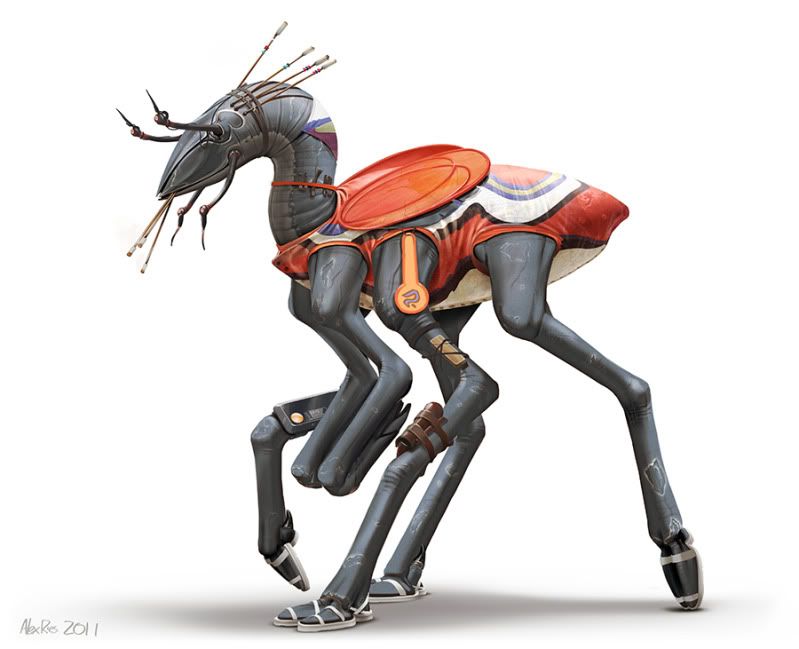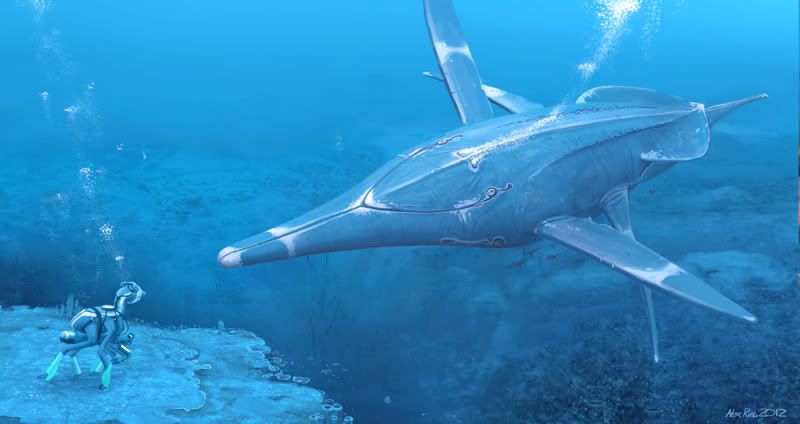A few new images expanding on the world of the species dubbed the Birrin.
First, the Birrin themselves!

"The Birrin are a sentient hexapod species from a planet approximately the size of Venus. This individual resides in the tropical region of their world, bordering the uninhabitably hot equatorial zone many birrin call the 'Kiln'. Low employment, high temperatures and generally harsh conditions mean that narcotic use is high among many of the population here.
This birrin, after ending a work cycle and with no further hive duties, uses and deals in most of the local low end narcotics. The three clasped in the beak offer an enjoyable combination of flavours when partaken together. Other mixes are stored in plain view under a strap on the head for sale or later use. As there is no substance control in this region, they can be shown in plain sight.
Addition accessories include a wrist mounted multimedia device, which feeds headphone cables to the auditory receptors at the tip of the upper two eyestalks; the device was likely traded illegally, or purchased from a wholesale shipment moving from the deep water docks on its way inland."
The Birrin have also taken to the oceans, using SCUBA gear.

"The oceans of the Birrin homeworld are populated by vast numbers of organisms, particularly the mid-latitude tropical zones on either side of the hostile equatorial 'Kiln'; a region of intense heat and violent storms. The surface waves and currents generated by these weather events create deep oceanic mixing, bringing nutrients to nearby surface waters and supporting the assemblages of life found there.
The birrin are at home in water, and many engage in swimming recreationally with or without the aid of SCUBA systems. Diving activities are associated with risks: as in this potentially dangerous encounter with the creature seen here.
Evolved from the same land-living ancestor as the birrin the Sardu, as they are locally known, are air breathing creatures of great strength and predatory skill. They range across most regions of the ocean, hunting diverse prey depending on local resources, and adjusting their strategies accordingly. All however rely on an extraordinary ability to generate powerful electric shocks via organs housed in their huge, elongated horizontal jaws. This allows them to stun entire schools of smaller organisms to consume at their leisure, or to probe their jaws into soft mud and detect, flush out kill benthic creatures of considerable size. The electrogenic organs also have a social purpose; and mating individuals compete to show both their ability to generate electricity, and to withstand the shocks of their adversaries. The small creatures that accompany sahdy as commensals must also be tolerant of this hazard, and most swim to a safe distance during the closing stages of a hunt, moving in to feast on the scraps afterwards.
The birrin diver seen here may seem in danger, however it is experienced with the local sardu and knows it is not a part of their prey search image; the constant stream of bubbles generated by the SCUBA gear and bright wetsuit look so unlike the large bottom dwelling creatures it usually hunts that it does not view the birrin as food."
Recent advances in submersible manufacturing have allowed birrin scienctists to explore the life that thrives miles below the oceans' surface...

"The deep oceans, while low in energy and deprived of oxygen and sunlight, are nevertheless home to numerous creatures. The beings of this ecosystem are able to exploit the abundant surface environment through either migrating vertically at night to feed, or by preying on creatures migrating into the deep to escape surface predators.
Sit and wait predation is an energy efficient way to hunt, and the Crystalline Cloakmouth represents an extreme adaptation to this way of life.
The reduced, soft body hangs below the highly modified mouthparts, which are dominated by huge vertical jaws spanning 13 inches from tip to tip. Sharp semitransparent mandibles are poised ready to snap shut on any prey lured inwards by the bioluminescent tip of the tongue. Prey that comes too close is skewered by the mandibles and then enclosed by the heavily pigmented jaws. This prevents they preys' defensive bioluminescence being detected by larger foes.
The two huge lower eyes are oriented upwards and modified to detect the bioluminescence of prey, or their shadows' against the downwelling surface light. The horizontal jaws, thin and elongated, are spread to the sides and covered in a line of fluid filled spheres able to detect vibrations in the water, a system also present around the rim of the main jaws. The horizontal mandibles are shorter and more robust than the crystalline seizing jaws, and are hidden away until prey is captured, which they proceed to butcher and then pass downwards into the pharynx.
The upper eyestalks are highly elongated and the post-ocular sections bifurcated into sensors adapted to detect the sex pheromones of conspecifics. Currents are so slow and the environment so vast that highly sensitive antennae are needed to detect minute concentrations of chemicals in the water. The small eyes on these tentacles are still functional but of low resolution; they monitor the light from the surface world and allow the Crystalline Cloakmouth to tell night from day.
Although ungainly, the Crystalline Cloakmouth can move quickly in short bursts to escape predators. Defence consists of several stages: First, the jaws with their large surface area are clamped rapidly together, shooting the creature away in the opposite direction. At the same time, thin translucent threads are extruded from modified limbs near the tail to form a mesh in the fleeing animals' wake. Predators caught in this are tangled by the sticky threads, which bioluminesce on contact and thus render the predator visible to its own enemies. Proteins on the Cloakmouths' skin inhibit this reaction when it becomes entangled in its own threads. As a final defence, the Crystalline Cloakmouth leaves the area using paired fins usually held tightly against its body, swimming slowly backwards to new hunting grounds. "
First, the Birrin themselves!

"The Birrin are a sentient hexapod species from a planet approximately the size of Venus. This individual resides in the tropical region of their world, bordering the uninhabitably hot equatorial zone many birrin call the 'Kiln'. Low employment, high temperatures and generally harsh conditions mean that narcotic use is high among many of the population here.
This birrin, after ending a work cycle and with no further hive duties, uses and deals in most of the local low end narcotics. The three clasped in the beak offer an enjoyable combination of flavours when partaken together. Other mixes are stored in plain view under a strap on the head for sale or later use. As there is no substance control in this region, they can be shown in plain sight.
Addition accessories include a wrist mounted multimedia device, which feeds headphone cables to the auditory receptors at the tip of the upper two eyestalks; the device was likely traded illegally, or purchased from a wholesale shipment moving from the deep water docks on its way inland."
The Birrin have also taken to the oceans, using SCUBA gear.

"The oceans of the Birrin homeworld are populated by vast numbers of organisms, particularly the mid-latitude tropical zones on either side of the hostile equatorial 'Kiln'; a region of intense heat and violent storms. The surface waves and currents generated by these weather events create deep oceanic mixing, bringing nutrients to nearby surface waters and supporting the assemblages of life found there.
The birrin are at home in water, and many engage in swimming recreationally with or without the aid of SCUBA systems. Diving activities are associated with risks: as in this potentially dangerous encounter with the creature seen here.
Evolved from the same land-living ancestor as the birrin the Sardu, as they are locally known, are air breathing creatures of great strength and predatory skill. They range across most regions of the ocean, hunting diverse prey depending on local resources, and adjusting their strategies accordingly. All however rely on an extraordinary ability to generate powerful electric shocks via organs housed in their huge, elongated horizontal jaws. This allows them to stun entire schools of smaller organisms to consume at their leisure, or to probe their jaws into soft mud and detect, flush out kill benthic creatures of considerable size. The electrogenic organs also have a social purpose; and mating individuals compete to show both their ability to generate electricity, and to withstand the shocks of their adversaries. The small creatures that accompany sahdy as commensals must also be tolerant of this hazard, and most swim to a safe distance during the closing stages of a hunt, moving in to feast on the scraps afterwards.
The birrin diver seen here may seem in danger, however it is experienced with the local sardu and knows it is not a part of their prey search image; the constant stream of bubbles generated by the SCUBA gear and bright wetsuit look so unlike the large bottom dwelling creatures it usually hunts that it does not view the birrin as food."
Recent advances in submersible manufacturing have allowed birrin scienctists to explore the life that thrives miles below the oceans' surface...

"The deep oceans, while low in energy and deprived of oxygen and sunlight, are nevertheless home to numerous creatures. The beings of this ecosystem are able to exploit the abundant surface environment through either migrating vertically at night to feed, or by preying on creatures migrating into the deep to escape surface predators.
Sit and wait predation is an energy efficient way to hunt, and the Crystalline Cloakmouth represents an extreme adaptation to this way of life.
The reduced, soft body hangs below the highly modified mouthparts, which are dominated by huge vertical jaws spanning 13 inches from tip to tip. Sharp semitransparent mandibles are poised ready to snap shut on any prey lured inwards by the bioluminescent tip of the tongue. Prey that comes too close is skewered by the mandibles and then enclosed by the heavily pigmented jaws. This prevents they preys' defensive bioluminescence being detected by larger foes.
The two huge lower eyes are oriented upwards and modified to detect the bioluminescence of prey, or their shadows' against the downwelling surface light. The horizontal jaws, thin and elongated, are spread to the sides and covered in a line of fluid filled spheres able to detect vibrations in the water, a system also present around the rim of the main jaws. The horizontal mandibles are shorter and more robust than the crystalline seizing jaws, and are hidden away until prey is captured, which they proceed to butcher and then pass downwards into the pharynx.
The upper eyestalks are highly elongated and the post-ocular sections bifurcated into sensors adapted to detect the sex pheromones of conspecifics. Currents are so slow and the environment so vast that highly sensitive antennae are needed to detect minute concentrations of chemicals in the water. The small eyes on these tentacles are still functional but of low resolution; they monitor the light from the surface world and allow the Crystalline Cloakmouth to tell night from day.
Although ungainly, the Crystalline Cloakmouth can move quickly in short bursts to escape predators. Defence consists of several stages: First, the jaws with their large surface area are clamped rapidly together, shooting the creature away in the opposite direction. At the same time, thin translucent threads are extruded from modified limbs near the tail to form a mesh in the fleeing animals' wake. Predators caught in this are tangled by the sticky threads, which bioluminesce on contact and thus render the predator visible to its own enemies. Proteins on the Cloakmouths' skin inhibit this reaction when it becomes entangled in its own threads. As a final defence, the Crystalline Cloakmouth leaves the area using paired fins usually held tightly against its body, swimming slowly backwards to new hunting grounds. "
Attached Images
Комментариев нет:
Отправить комментарий